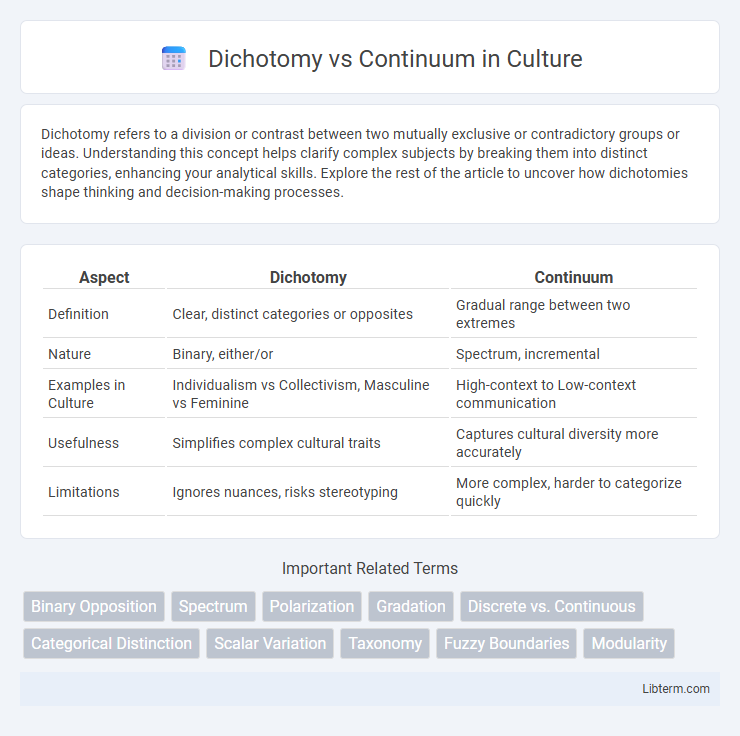Dichotomy refers to a division or contrast between two mutually exclusive or contradictory groups or ideas. Understanding this concept helps clarify complex subjects by breaking them into distinct categories, enhancing your analytical skills. Explore the rest of the article to uncover how dichotomies shape thinking and decision-making processes.
Table of Comparison
| Aspect | Dichotomy | Continuum |
|---|---|---|
| Definition | Clear, distinct categories or opposites | Gradual range between two extremes |
| Nature | Binary, either/or | Spectrum, incremental |
| Examples in Culture | Individualism vs Collectivism, Masculine vs Feminine | High-context to Low-context communication |
| Usefulness | Simplifies complex cultural traits | Captures cultural diversity more accurately |
| Limitations | Ignores nuances, risks stereotyping | More complex, harder to categorize quickly |
Introduction to Dichotomy and Continuum
Dichotomy refers to the division of a concept or phenomenon into two mutually exclusive and opposite categories, creating a clear boundary between contrasting elements. Continuum represents a gradual progression or spectrum where distinctions between categories are blurred, allowing for intermediate states rather than rigid separation. Understanding the difference between dichotomy and continuum is essential in fields such as psychology, biology, and social sciences for accurately interpreting complex traits and behaviors.
Defining Dichotomy: Clear-Cut Boundaries
Dichotomy refers to a classification system that divides concepts into two mutually exclusive and clearly defined categories, establishing distinct, non-overlapping boundaries. This binary framework simplifies complex information by creating sharp contrasts, often used in areas such as logic, linguistics, and social sciences to clarify differences. Defining dichotomies provide precise distinctions essential for analytical clarity but may overlook nuanced variations found in real-world phenomena.
Exploring the Continuum: Gradual Transitions
The concept of a continuum emphasizes gradual transitions rather than abrupt dichotomies, allowing for a spectrum of intermediate states between two extremes. This approach is critical in fields like psychology, where traits such as personality or intelligence are better understood as fluid ranges rather than fixed categories. Acknowledging the continuum supports more nuanced analysis and avoids oversimplification inherent in dichotomous thinking.
Key Differences Between Dichotomy and Continuum
Dichotomy refers to a division between two mutually exclusive categories with no overlap, representing a clear-cut contrast such as binary oppositions in logic or taxonomy. Continuum, in contrast, encompasses a gradual range or spectrum where distinctions are not sharply separated but blend seamlessly, as seen in concepts like color gradients or personality traits. Key differences include the discrete, polarized nature of dichotomies versus the fluid, incremental variability inherent in continua, affecting classification, analysis, and interpretation across disciplines.
Historical Perspectives on Dichotomous Thinking
Historical perspectives on dichotomous thinking trace back to ancient philosophy, where binary oppositions like good versus evil or mind versus body framed understanding. This rigid categorization dominated medieval scholasticism and Enlightenment thought, reinforcing clear-cut divisions that influenced science, religion, and social structures. Over time, critiques emerged highlighting the limitations of such dichotomies, paving the way for more nuanced continuum-based models in contemporary disciplines.
The Rise of Continuum Models in Modern Science
Continuum models have gained prominence in modern science by providing nuanced frameworks that better capture complex phenomena than traditional dichotomies. Fields such as psychology, physics, and social sciences increasingly favor continuums to represent variables that vary gradually rather than existing in binary states. This shift enables more accurate predictions and deeper understanding of dynamic systems by acknowledging the spectrum of intermediate possibilities.
Common Examples in Everyday Life
Many everyday concepts illustrate the dichotomy versus continuum debate, such as light switches being a clear dichotomy with states either on or off, while dimmer switches represent a continuum with gradual intensity levels. Human emotions often fall on a continuum from happiness to sadness rather than a strict dichotomy, allowing for nuanced feelings like contentment or melancholy. Similarly, temperature perception ranges continuously from cold to hot, unlike binary categories like pass/fail grades or digital signals that exemplify clear dichotomies.
Advantages and Limitations of Each Approach
Dichotomy provides clear, binary categories that simplify decision-making and enhance clarity in classification systems, but it often overlooks nuanced variations and complexity within data. Continuum offers a more flexible framework capturing gradations and diverse characteristics, improving accuracy in representing real-world phenomena; however, it can be less practical for quick assessments and may introduce ambiguity. Balancing dichotomous clarity with continuum flexibility is essential for effective analysis in fields like psychology, medicine, and social sciences.
When to Use Dichotomy Versus Continuum
Dichotomy is ideal for categorizing data into two distinct, mutually exclusive groups when clear boundaries exist, such as gender classification or binary decision outcomes. Continuum is preferable for representing variables with gradual or infinite variations, like temperature scales or levels of agreement, capturing nuanced differences effectively. Use dichotomy when simplicity and clarity are paramount, whereas continuum suits complex, spectrum-based analyses requiring detailed distinctions.
Conclusion: Bridging the Gap Between Extremes
Dichotomy and continuum represent two contrasting frameworks for understanding concepts, with dichotomies emphasizing clear-cut categories and continuums highlighting gradual transitions. Bridging the gap between these extremes involves recognizing that many phenomena exhibit both distinct boundaries and fluid variations, allowing for more nuanced analysis and decision-making. Integrating dichotomous clarity with continuum flexibility enhances cognitive models and supports more effective problem-solving across disciplines.
Dichotomy Infographic

 libterm.com
libterm.com